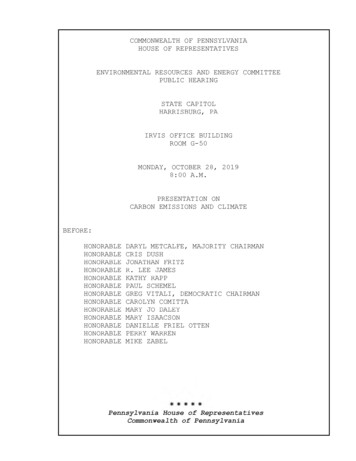
Transcription
OPENING STATEMENT OF THE HONORABLE TIM MURPHYCHAIRMAN, OVERSIGHT AND INVESTIGATIONS SUBCOMMITTEE“EXAMINING HRSA’S OVERSIGHT OF THE 340B DRUG PRICING PROGRAM.”JULY 18, 2017Today, the Subcommittee is holding a hearing entitled “Examining HRSA’sOversight of the 340B Drug Pricing Program.” The 340B program was created byCongress in 1992 and mandates that drug manufacturers provide outpatient drugsto eligible entities at reduced prices in order for the manufacturers to remaineligible for reimbursements through entitlement programs such as Medicaid andMedicare.340B program-covered entities are nonprofit health care organizations thathave certain federal designations or receive funding from specific federalprograms. Federal grantees are eligible for the 340B program by receiving certainfederal grants administered by different agencies within HHS. Hospitals eligiblefor the 340B program include certain Disproportionate Share Hospitals, children’shospitals, freestanding cancer hospitals, rural referral centers, sole communityhospitals, and critical access hospitals.The Health Resources and Services Administration, or “HRSA,” an agencyin the U.S. Department of Health and Human Services, is tasked with acceptingapplications and overseeing covered entities.
HRSA faces several challenges in conducting oversight of the 340Bprogram, one of which is the lack of reporting requirements in the 340B statute.Participating entities save between 25-50 percent of the average wholesale pricefor covered outpatient drugs, and according to the HHS Office of InspectorGeneral’s estimates, covered entities saved 6 billion on drug expenditures inFiscal Year 2016. However, covered entities are not required to report their annualsavings through participation in the program, or how they use the money saved.For many of these covered entities, those savings are vital to the entity’ssurvival, particularly those that serve a large percentage of indigent patients andoperate at a loss each year. Other entities reinvest those savings in patient care,expanding access to patient care by opening centers in rural and underserved areasor passing along the savings to patients by providing discounted drugs. However,as with so many federal programs, there are instances of errors and misuse.Specialists, oncologists in particular, have told me stories of their graveconcerns about the way some entities use the 340B program. For example, onestory involves a doctor who referred many uninsured, young breast cancer patientsto a 340B hospital to receive cancer treatments, but watched as 16 of those patients2
were placed on a waitlist for care, simply waiting for treatment while their cancerprogressed from entirely treatable, to potentially life-threatening. According to thisdoctor, the waitlist was not due to an overall capacity issue. Instead, it was becausethe hospital simply chose to set a cap on the number of uninsured patients theywould treat.I hope that these instances are outliers – the exception to the rule. Theintegrity of the 340B program must be protected. HRSA must be able to conductoversight in a way that allows it to uncover fraud and non-compliance. Indeed,HRSA audits from FY 2012 to FY 2016 demonstrate that non-complying entitiesviolate program requirements through duplicate discounts, diversion to ineligiblepatients and facilities, and incorrect database reporting. Unfortunately, whileHRSA has made improvements to their oversight efforts in recent years, theagency simply may not have the resources to adequately safeguard the program.The program has experienced dramatic growth in recent years, due in part toprogram expansions in the Patient Protection and Affordable Care Act. At ahearing before the Health Subcommittee in 2015, we learned that from 2001 to2011, the number of covered entities participating in the program roughly doubled.The most recent data shows that from 2011 to 2017, the number of entities has3
nearly quadrupled. HRSA indicates that as of October 2016, 12,148 coveredentities were participating in the 340B program.Despite that growth, HRSA maintains only 22 staff to oversee the 340Bprogram, and conducts roughly 200 audits annually. While HRSA has increasedthe number of audits conducted annually, which the Committee applauds HRSAfor, that number is still dwarfed by the vast number of participating entities andmanufacturers. At the current level of annual audits conducted, HRSA is auditinga mere 1.6% of covered entities annually. Further, because HRSA’s audits consistof only a sample of drugs within each entity, these audits cover just a fraction of afraction of the program. Despite that, HRSA’s audits have uncovered between 63and 82 percent of audited entities to be non-compliant with program requirementssince 2012. What would more intensive oversight, including additional audits,further reveal?I thank HRSA for their cooperation in producing audit documents before thishearing in response to the Committee’s request last month. We’re in the process ofreviewing these documents to gain a better understanding of the audit process andmay have more follow-up questions at a later date.4
I welcome the witnesses appearing before us today and look forward tohearing about HRSA’s oversight efforts, the challenges HRSA faces, and how thisCommittee can best enable HRSA to overcome those challenges.5
OPENING STATEMENT OF THE HONORABLE TIM MURPHY CHAIRMAN, OVERSIGHT AND INVESTIGATIONS SUBCOMMITTEE "EXAMINING HRSA'S OVERSIGHT OF THE 340B DRUG PRICING PROGRAM." JULY 18, 2017 Today, the Subcommittee is holding a hearing entitled "Examining HRSA's Oversight of the 340B Drug Pricing Program." The 340B program was created by










